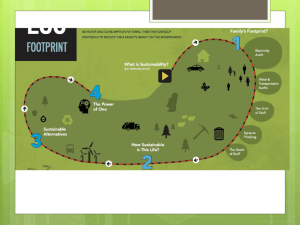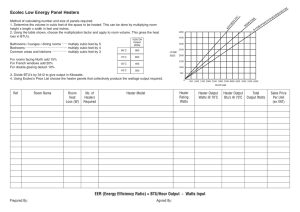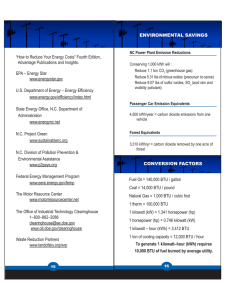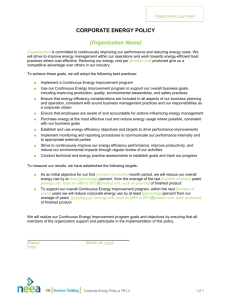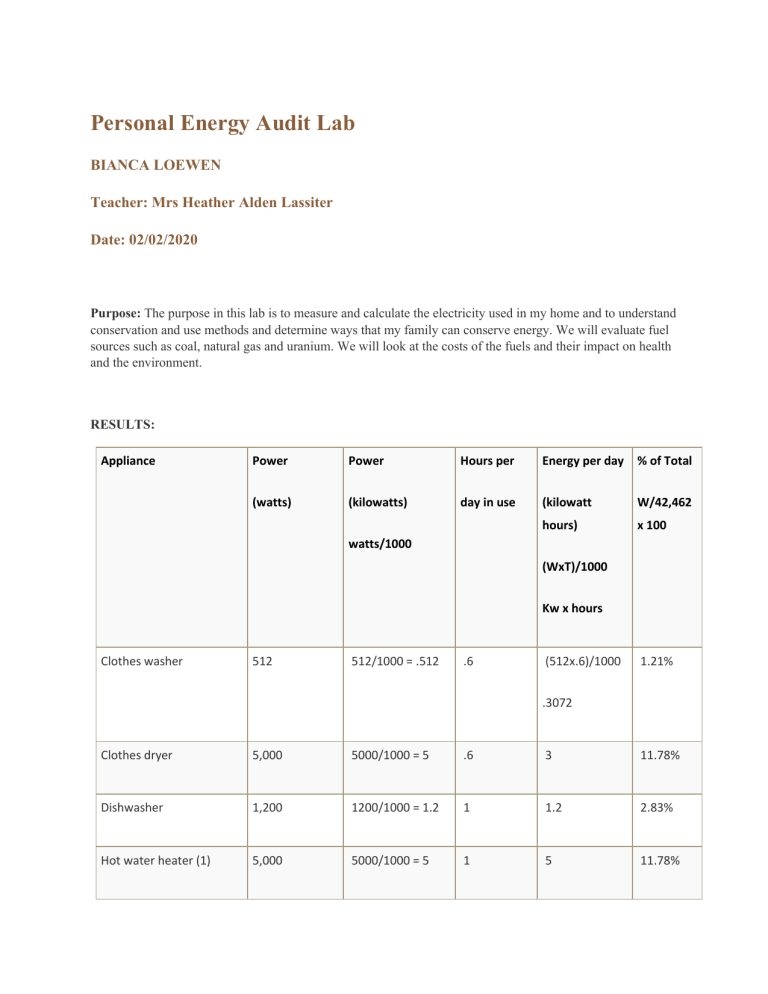
Personal Energy Audit Lab BIANCA LOEWEN Teacher: Mrs Heather Alden Lassiter Date: 02/02/2020 Purpose: The purpose in this lab is to measure and calculate the electricity used in my home and to understand conservation and use methods and determine ways that my family can conserve energy. We will evaluate fuel sources such as coal, natural gas and uranium. We will look at the costs of the fuels and their impact on health and the environment. RESULTS: Appliance Power Power Hours per Energy per day % of Total (watts) (kilowatts) day in use (kilowatt W/42,462 hours) x 100 watts/1000 (WxT)/1000 Kw x hours Clothes washer 512 512/1000 = .512 .6 (512x.6)/1000 1.21% .3072 Clothes dryer 5,000 5000/1000 = 5 .6 3 11.78% Dishwasher 1,200 1200/1000 = 1.2 1 1.2 2.83% Hot water heater (1) 5,000 5000/1000 = 5 1 5 11.78% Air conditioning/Heating 1,300 per room 12 rooms (count ALL 12x1300= 15,600 4 62.4 36.74% rooms, even bathrooms, 15600/1000= 15.6 but not closets) 15,600 Refrigerator 800 800/1000 = .8 24 19.2 1.88% Blender 300 300/1000 = .3 1 .3 0.71% Food processor 350 350/1000 = .35 1 .35 0.82% Microwave 750 750/1000 = .75 1 .75 1.77% Range/oven 3,500 3500/1000 = 3.5 2 7 8.24% Toaster 1,200 1200/1000 = 1.2 0 0 2.83% Computer 75 75 x 4 =300 2 .6 .7% 300 300/1000 = .30 Radio/Stereo 70 70/1000 .07 .5 .035 .17% LCD Television 200 200 x 4 = 800 2 1.6 1.88% 800 800/1000 = .8 DVD or VCR 50 50/1000 = .05 .5 .025 0.12% Fan (2) 100 200/1000 = .2 16 3.2 0.47% 200 Vacuum cleaner 650 650/1000 = .65 .5 .325 1.53% Lightbulbs (62) Count all 65 x 62 = 4030 10 40.3 9.49% lightbulbs and watts 9 .45 0.12% multiply by average of 65 4030/1000 =4.03 watts for each one 4030 Plugged in chargers 5 for each one 5 x 10 = 50 watts (for cell phones, laptops, 50 50/1000 = .05 Iron 1,000 1000/1000 = 1 0 0 2.36% Hair dryer 1,200 1200/1000 = 1.2 .2 .24 2.83% TOTAL 42,462 watts 42.462 kilowatts 76.9 hrs 146.282 kwh etc., even when not in use) (10) 1. How much electrical energy does your family consume per day, in kwh? How much would that be for a year, in kwh? My family consumes 152.9222 kwh per day. We would use 53,392.93 kwh in a year. (146.282 x 365) 2. Convert your family’s yearly energy use to BTUs. 1 kwh = 3,412 BTU. 53,392.93 x 3412 = 182,176,677 BTU’s. CONVERSION FACTORS 1 kwh (kilowatt hour) = 3,412 BTU 1 BTU = 1055 Joules 1 pound bituminous coal = 12,000 BTU 1 barrel oil = 5,800,000 BTU 1 cubic foot of natural gas = 1,028 BTU 1 gram uranium = 4 x 10^ 7 BTU 3. Complete this table using your answer for question 2: How much of these energy sources are needed to provide your family’s yearly energy? Coal Pounds needed = 15,181.39 lbs 182,176,677 BTUs /12,000 = 15,181.39 Natural Gas Cubic feet needed 177,214.666 cubic feet 182,176,677 BTUs / 1.028 = 177,214.666 Oil Uranium Barrels needed 31.41 barrels (182,176,677/5,800,0000) 4. Grams needed = Grams needed = 4.5544 grams 182176677/ 4 x 10^ 7 = 4.55 4 Complete this Table using your answers from Question 3 How much do your energy sources cost for a year of your family’s electricity? Coal costs about $25 per ton Total cost = $189.75 1 ton = 2000lbs. 15,181.39/2000 = 7.59 7.59 x 25= 189.75 5. Oil costs about $90 per barrel Total cost = $2826.90 31.41 x 90 = 2826.9 6. Natural Gas costs about $5 per 1000 cubic feet 7. Total cost = $886.05 177,214.666/1000 =177.21 177.21 x 5 = 886.05 8. Uranium costs about 2 cents per gram 9. Total cost = about 10 cents 4.5544 x .02 = 0.091088 5 Is the cheapest fuel the best choice? What costs are not included here? How should the "best" fuel be determined? The cheapest fuel is not always the best choice. To create usable energy from uranium, it has to be processed in a nuclear power plant. Nuclear power plants are very expensive to build and have significant operating costs. There are also the direct and indirect environmental impacts and costs to consider. Examples: The negative impact on people’s health, the costs of caring for medical issues and the costs of cleaning up potential contamination. The best fuel should factor in the environmental costs as well. These energy sources are non renewable so it’s hard to pick. They all have faults. We have to weigh the pros and cons and then make the decision based on what works best. Analyze your family’s electricity usage: A. Compare your family’s electricity usage to how energy is used in other homes in the United States using information in the lesson. My family is similar in usage in other homes when it comes to energy use. Much of our energy use is put into heating and air conditioning, hot water, lighting and appliances related to cooking and cleaning. The percentages may be different but in general our energy usage is very similar to other homes. B. Outline five ways to reduce your family’s electricity usage. Use air conditioning only as needed and turn the thermostat up a few degrees in summer and down a few degrees in winter. Use our cooking devices more efficiently Wash larger loads of laundry. Unplug gaming consoles, devices and chargers when they’re not being used or needed Turn off the heater when no one is home and dress warmer around the house. C. Discuss the feasibility of your proposals and your family’s acceptance of change. The proposed changes are not going to create a significant problem. I think everyone will be receptive to them. It is a good start and if we all become more aware of our energy usage and how we can make a difference. This will help us in our decision and in making future changes. With less usage, there will also be cost savings on energy and that is a strong selling point. My family would be very accepting of these ideas. In conclusion, In this lab I learned about what types of energy we use in our household, how much energy we use, and in which areas we use the most energy. Our energy consumption is similar to other households. This lab provided awareness and thus it was able to give me some insight on how we can make a difference in our household energy usage. The lab showed me the advantages and disadvantages of using nonrenewable sources instead of renewable resources. We can make some minor changes just by being aware of energy usage and easily implement some changes to reduce our consumption of energy. The lab showed me how to help my family members do the same.
